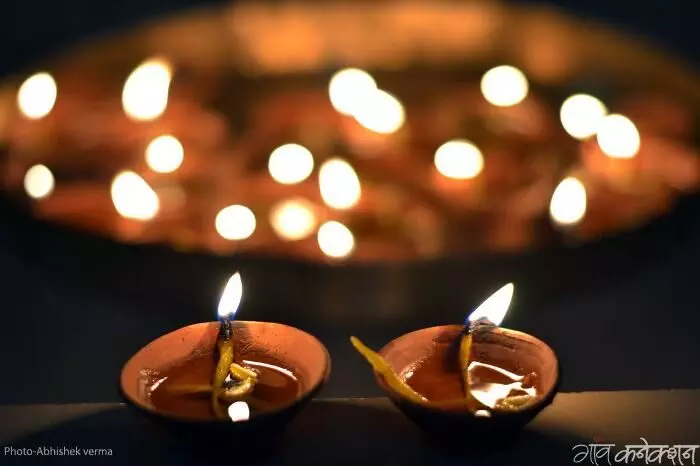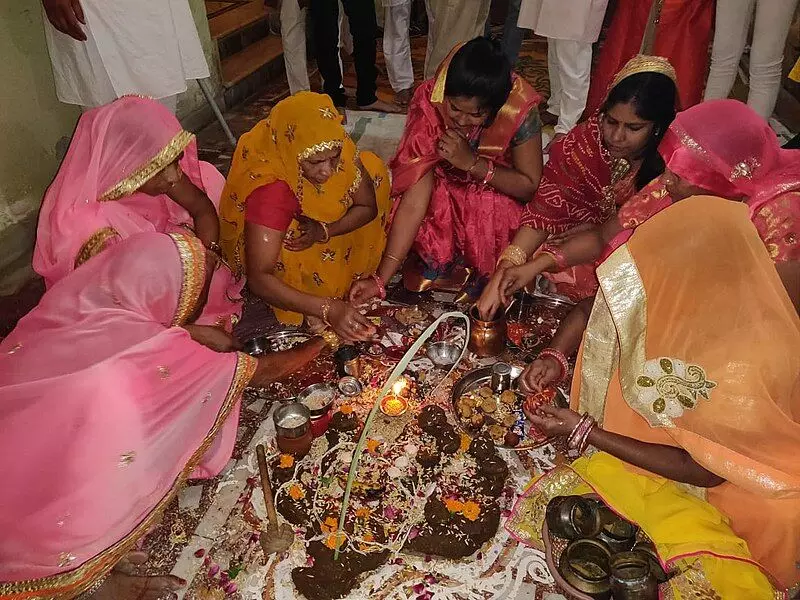The festival of Diwali is commonly
observed as a culmination of sorts, marking more-or-less the end of the
festival season and celebrated with much fanfare and gaiety. People shop for
their families, friends, clients and employees, host card parties, illuminate
houses and establishments, burst crackers, albeit responsibly, and undertake
fun festive food binging.
This festival, broadly celebrating the
homecoming of Lord Rama and to mark the victory of light upon darkness, is
signified by a diya (earthen lamp) and so is called a festival of lights, but,
in fact, is much more than that. Present-day festivities are limited by the
modern urban life experiences whereas traditionally festivals in India took an individual
to the community and were varied and numerous in their modes of celebrations
spread over a fortnight.
Diwali is also observed as the day of
Kali puja in West Bengal which celebrates the dark goddess in her fearsomeness.
Diwali celebrations begin from Dhanteras and go on till Dev Diwali. The day
succeeding Diwali is celebrated as Govardhan Puja which dually celebrates the
cattle and Krisna’s use of Govardhan Mountain to provide his people succour from
the Rain God Indra’s ire. People light diyas on the mounds of dung and offer
prayers. Two days after Diwali is the festival of Bhai Dooj, which celebrates
the brother-sister bond.
During Diwali, many people in
Purvanchal also observe the ritual of ‘Dalidder’ (poverty) wherein they go
about the house beating a battered soop
(a woven basket or fan for winnowing) chanting Ishwar baithe, Dalidder Nikle, Lachmi Kare Ghar Vas (May God be in
our house, may the poverty leave us, may our house prosper with the presence of
Goddess Laxmi). The community then gathers and lights up a bonfire and the soops are thrown into the fire. The Marwari
community does it during Choti Diwali while many perform it on Ekadashi. People
in Uttar Pradesh eat suran (yam) for
it is believed that the bite of suran
cuts away the sins of the entire year.

Diwali is also observed as the day of Kali puja in West Bengal.
The Uttar Pradesh, the Khatris layout
rangoli in the form of a Chaupar (India ludo) and place Laxmi-Ganesh
idols on its. Puffed rice is placed by the daughters of the house upon various
colourfully decorated earthen toys and who also place thumms or ritualistic vermillion markings to symbolically express
their desire and prayers for the prosperity of their mother’s home.
Diwali is celebrated as Bagwal in Garhwal region of Uttarakhand.
Bagwal is observed as Choti, Badi and Egas (small, big and Ekadashi). The way people light up sparklers
and candles, the Garhwalis make use of bhailu
and hulki. Inner shavings of pine
tree are tied together with a local creeper sirola
. The resulting bunch called hulki is lighted up which is then hung by thick
nails to light up the courtyards. Placing a thali
above it, the black residue is collected and applied as kohl. Bhailu is hulki tied to a long creeper like a big yo-yo and whisked in a
circular motion on the fields on all three days. Men and women compete joyously
to see who plays the longest. Beginning Choti
Diwali, the bereaved are sent out food items made from kulthi (horse gram) and ranaas
(rice bean).
Among people of Damoh, Chattarpur in
Madhya Pradesh, the festival of Gaur
Chiraiyya is celebrated soon after Diwali wherein women take seven sticks
of Khoya and fashion them into a bird.
At the appointed wall for puja, a tree with a bird is made. Women gather around
to hear the story and put a lighted diya upon the khoya bird’s beak. Thereafter, the bird body except for its tail is
eaten up and the tail is tossed away behind the shoulder. All married women
observe this ritual and taint their feet red.

On Bhai dooj, women sitting in a circle worship a mound of cow dung and Ganesh and listen to the story
Another major festival of the Diwali
season is that of Govardhan or Annakoot which is observed the day after
Diwali. It is believed the Lord Krisna hoisted the Govardhan Mountain on his
small finger to provide shelter and save his devotees from the rain god’s ire.
So, a mound of cow dung is symbolically worshipped as Govardhan Mountain by
placing a diya atop and ritualistic
offerings made to Krisna which is called Annakoot
or a medley of all food items. People also mark this day by worshipping cows. Uttar
Pradesh Khatris save up the vegetables offered on Ahoi Ashtami and cook all of
them together as annakoot offering
after Diwali.
Two days after comes the festival of Bhaidooj
which celebrates the bond of brothers and sisters like Rakhi or Rakshabandhan.
It is believed that Yama visited his sister Yamuna or Yami this day and Yamuna
elated at her brother’s visit, welcomed him anointing his forehead with
vermillion (tilak) and made him up a feast. Pleased with Yami, Yama asked him
what she desired to which she replied that whosoever took a dip in her water
with his sister on that day shall transcend the cycle of birth and death. Yama
agreed and so it is considered auspicious for brother-sisters to take a dip in
Yamuna at daybreak on Bhaidooj. It is a ritual observed keenly by people in
Mathura.
Towards Purvanchal, sisters begin by
symbolic cursing of their brothers holding a local thorny stick, bhatkatiya. Sitting in a circle they
worship a mound of cow dung and Ganesh and listen to the story. Thereafter, the
curse is revoked with water and the next day on Bhaidooj brothers are treated
to the feast of stuffed pooris and bakheer.
Mostly symbolic, these chapters of the
larger festival of Diwali, nonetheless, enrich the meaning and experiences of
the festivals. Each of these festivals is linked to another to showcase the
common love and importance of relations by making members of the community
celebrate them together.




















